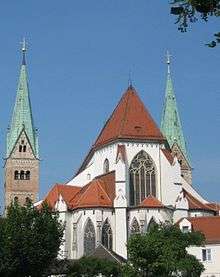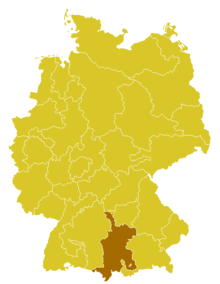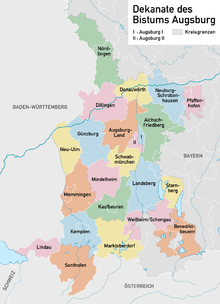Roman Catholic Diocese of Augsburg
| Diocese of Augsburg Dioecesis Augustanus Vindelicorum | |
|---|---|
 Augsburg Cathedral | |
| Location | |
| Country | Germany |
| Ecclesiastical province | Munich and Freising |
| Metropolitan | Archdiocese of Munich and Freising |
| Statistics | |
| Area | 13,250 km2 (5,120 sq mi) |
| Population - Total - Catholics |
(as of 2012) 2,298,454 1,351,703 (58.8%) |
| Parishes | 1,004 |
| Information | |
| Denomination | Roman Catholic |
| Rite | Roman Rite |
| Established | 6th Century |
| Cathedral | Augsburg Cathedral |
| Co-cathedral | Dillingen an der Donau Co-cathedral |
| Patron saint |
St. Ulric of Augsburg St. Simbert of Augsburg St. Afra |
| Current leadership | |
| Pope | Francis |
| Bishop |
Konrad Zdarsa Bishop of Augsburg |
| Metropolitan Archbishop |
Reinhard Marx Archbishop of Munich and Freising |
| Auxiliary Bishops |
Anton Losinger Florian Wörner |
| Vicar General | Harald Heinrich |
| Emeritus Bishops |
Viktor Josef Dammertz, O.S.B. Walter Mixa Josef Grünwald Maximilian Ziegelbauer |
| Map | |
 | |
| Website | |
| bistum-augsburg.de | |

Diocese of Augsburg is a diocese of the Catholic Church in Germany. The diocese is a suffragan of the Archdiocese of Munich.[1][2]
Early period
According to the acts of the martyrdom of St. Afra, who with her handmaids suffered at the stake for Christ, there existed in Augsburg early in the fourth century a Christian community under Bishop Narcissus. St. Dionysius, uncle of St. Afra, is mentioned as his Successor.
History
After the Congress of Vienna, where the diocese was restored, Franz Karl von Hohenlohe-Schillingsfurst (d. 1819) was appointed bishop and Joseph Maria von Fraunberg was soon called to the archdiocese of Bamberg. There, they devolved upon their successors the important task of rearranging the external conditions and reanimating religious life, which had suffered sorely. Ignatius Albert von Riegg (1824-36) was successful in his endeavors to further the interests of souls, to raise the standard of popular education through the medium of numerous ordinances and frequent visitations. He assigned the administration and direction of studies in the Lyceum to the monks of the Benedictine Abbey of St. Stephen in Augsburg, founded by King Ludwig I of Bavaria (1834).
Petrus von Richarz (1837-55) displayed energy and persistent zeal in promoting the interests of his diocese and the Catholic Church in general, and encouraged the giving of missions to the people, the establishment of many religious institutions for the care of the sick and for educational purposes, and carefully superintended the training of the clergy. The same spirit characterized the labours of the succeeding bishops: Michael von Deinlein (1856-58), who after a short episcopate was raised to the Archbishopric of Bamberg; Pankratius von Dinkel (1858-94), under whom both seminaries and the deaf and dumb asylum were established in Dillingen, and many monastic institutions were founded; Petrus von Hotzl (1895-1902) whose episcopate was marked by the attention paid to social and intellectual pursuits, and the number of missions given among the people as well as by the solemn celebration of the beatification of the pious nun Crescentia Hoss. He was succeeded by Maximilian von Lingg.
Ordinaries

- Peter von Schaumberg † (28 Feb 1424 Appointed - 12 Apr 1469 Died)
- Johann Graf von Werdenberg † (15 May 1469 Appointed - 23 Feb 1486 Died)
- Friedrich Graf von Hohenzollern † (21 Mar 1486 Appointed - 8 Mar 1505 Died)
- Heinrich von Lichtenau † (1 Apr 1505 Appointed - 12 Apr 1517 Died)
- Christoph von Stadion † (20 Apr 1517 Confirmed - 15 Apr 1543 Died)
- Otto Truchseß von Waldburg † (10 May 1543 Appointed - 2 Apr 1573 Died)
- Johann Eglof von Knöringen † (18 May 1573 Appointed - 4 Jun 1575 Died)
- Marquard von Berg † (26 Jul 1575 Appointed - 29 Jan 1591 Died)
- Johann Otto von Gemmingen † (21 Mar 1591 Appointed - 6 Oct 1598 Died)
- Heinrich von Knöringen † (19 Apr 1599 Appointed - 25 Jun 1646 Died)
- Sigmund Franz Erzherzog von Österreich † (25 Jun 1646 Succeeded - 28 May 1665 Resigned)
- Johann Christoph Reichsritter von Freyberg-Allmendingen † (18 Aug 1665 Appointed - 1 Apr 1690 Died)
- Alexander Sigmund Pfalzgraf am Rhein zu Neuburg † (1 Apr 1690 Succeeded - 24 Jan 1737 Died)
- Johann Franz Reichsgraf von Schenk von Stauffenberg † (24 Jan 1737 Succeeded - 12 Jun 1740 Died)
- Joseph Ignaz Philipp Landgraf von Hessen-Darmstadt † (18 Aug 1740 Appointed - 20 Aug 1768 Died)
- Klemens Wenzeslaus Herzog von Sachsen † (20 Aug 1768 Succeeded - 27 Jul 1812 Died)
- Franz Karl Joseph Fürst von Hohenlohe-Waldenburg-Schillingsfürst † (5 Feb 1818 Appointed - 9 Oct 1819 Died)
- Joseph Maria Johann Nepomuk Freiherr von Fraunberg † (6 Dec 1819 Appointed - 4 Mar 1824 Appointed, Archbishop of Bamberg)
- Ignatz Albert (Joseph Ignatz Alexius) von Riegg, O.S.A. † (4 Mar 1824 Appointed - 15 Aug 1836 Died)
- Johann Peter von Richarz † (20 Sep 1836 Appointed - 2 Jul 1855 Died)
- Michael von Deinlein † (12 Jan 1856 Appointed - 17 Jun 1858 Appointed, Archbishop of Bamberg)
- Pankratius von Dinkel † (16 Jul 1858 Appointed - 8 Oct 1894 Died)
- Petrus von Hötzl, O.F.M. † (7 Nov 1894 Appointed - 9 Mar 1902 Died)
- Maximilian von Lingg † (18 Mar 1902 Appointed - 31 May 1930 Died)
- Joseph Kumpfmüller † (17 Sep 1930 Appointed - 9 Feb 1949 Died)
- Josef Freundorfer † (9 Jul 1949 Appointed - 11 Apr 1963 Died)
- Josef Stimpfle † (10 Sep 1963 Appointed - 30 Mar 1992 Retired)
- Viktor Josef Dammertz, O.S.B. (24 Dec 1992 Appointed - 9 Jun 2004 Retired)
- Walter Mixa (16 Jul 2005 Appointed - 8 May 2010 Resigned)
- Konrad Zdarsa (8 Jul 2010 Appointed - )

Auxiliary bishop
- Jean Heysterbach, O.P. (1436–1447)[3]
- Wilhelm Mader, O. Praem. (1447–1450)[4]
- Martin Dieminger (1450–1460)
- Jodok Seitz, O. Praem. (1460–1471)[5]
- Jakob Goffredi (1471–1473)
- Ulrich Geislinger, O.F.M. (1474–1493)
- Johann Kerer (1493–1506)
- Heinrich Negelin (Nagele) (1506–1520)
- Johann Laymann (1521–1546)
- Marcus Vetter (1546–1554)
- Sebastian Breuning (1586–1618)
- Michael Dornvogel 1554–1586)
- Peter Wall (bishop) (1618–1630)
- Sebastian Müller (1631–1644)
- Kaspar Zeiler (1646–1665)
- Johann Eustach Egolf von Westernach (1681–1707)
- Johann Kasimir Röls (1708–1715)
- Franz Theodor von Guttenberg (1716–1717)
- Johann Jakob von Mayer (1718–1749)
- Franz Xaver von Adelmann von Adelmannsfelden (1750–1787)
- Johann Nepomuk August Ungelter von Deisenhausen (1779–1804)
- Franz Karl Joseph von Hohenlohe-Waldenburg-Schillingsfürst (1802–1818) Appointed Bishop of Augsburg
- Johann Baptist Judas Thaddeus von Keller (1816–1828)
- Peter Göbl (1911–1916)
- Josef Kumpfmüller (1930–1949)
- Franz Xaver Eberle 1934–1951)
- Manfred Müller (1972–1982)
- Karl Reth (1916–1933)
- Joseph Zimmermann (1952–1972)
- Rudolf Schmid (1972–1990)
- Maximilian Ziegelbauer (1983–1998)
- Josef Grünwald (1995–2011)
- Anton Losinger (2000–)
- Florian Wörner (2012–)
References
- ↑ "Diocese of Augsburg" Catholic-Hierarchy.org. David M. Cheney. Retrieved February 29, 2016
- ↑ "Diocese of Augsburg" GCatholic.org. Gabriel Chow. Retrieved February 29, 2016
- ↑ "Bishop Jean Heysterbach, O.P." Catholic-Hierarchy.org. David M. Cheney. Retrieved July 26, 2016
- ↑ "Bishop Wilhelm Mader, O. Praem." Catholic-Hierarchy.org. David M. Cheney. Retrieved July 26, 2016
- ↑ "Bishop Jodok Seitz, O. Praem." Catholic-Hierarchy.org. David M. Cheney. Retrieved July 26, 2016
-
 This article incorporates text from a publication now in the public domain: Herbermann, Charles, ed. (1913). "article name needed". Catholic Encyclopedia. New York: Robert Appleton.
This article incorporates text from a publication now in the public domain: Herbermann, Charles, ed. (1913). "article name needed". Catholic Encyclopedia. New York: Robert Appleton.
Coordinates: 48°22′22″N 10°53′48″E / 48.37278°N 10.89667°E